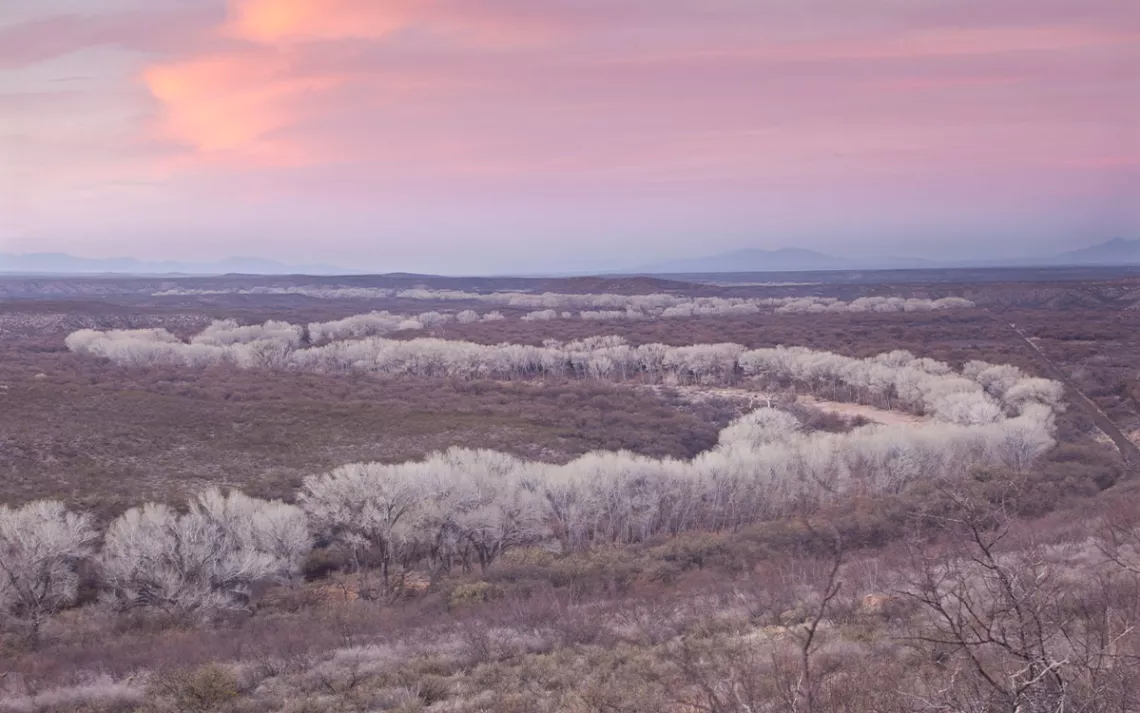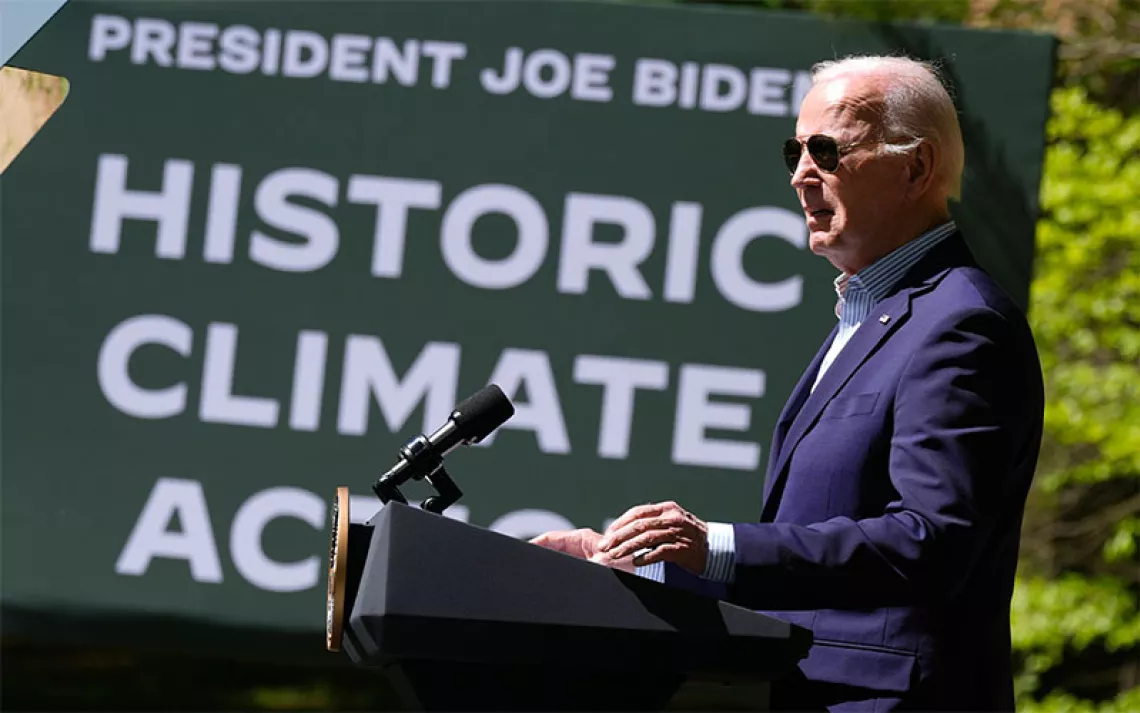Conservation Could Get a Huge Boost on Millions of Acres
A new analysis shows most Americans support the proposal to make that happen

The San Pedro riparian area was designated as a national conservation area in 1988 to protect and enhance the ecosystem, a rare remnant of what was once an extensive network of similar riparian systems throughout the Southwest. | Photo by Bob Wick/BLM
In Southern California, about 140 miles east of Los Angeles, massive sand dunes sweep across the Mojave Trails landscape, near unforgiving desert mountains and one of the largest freshwater spring complexes in the region. Here, critically endangered desert tortoises burrow and trot across the cracked earth, prairie falcons patrol the skies, and common chuckwallas skitter between the rocks.
But unlike its more famous next-door neighbor, Joshua Tree National Park, the 1.6 million acres of Mojave Trails are not a national park. Instead, they’re a part of the sprawling system of public lands controlled by the Bureau of Land Management (BLM), one of the most important branches of the federal government, directly overseeing about 10 percent of all land in the country, mainly in western states. But BLM lands aren’t just for conservation and recreation. Instead, they are home to everything from reservoirs and wilderness reserves to livestock grazing and coal mines. Managing public lands for “multiple use” has been at the center of the bureau’s mission for decades.
This past spring, however, the Biden administration proposed new regulations that would help ensure conservation is among those uses. These changes might, at first glance, seem like wonky regulatory updates, but the public comment period on these proposals just closed with more than 150,000 entries, and an estimated 92 percent of them are in favor of the rule, according to a new analysis conducted by the Center for Western Priorities. And what’s more, these rules could help shape the country’s ecological future amid growing threats from climate change and biodiversity loss.
“BLM’s job is to make sure public lands are serving the interests of all Americans,” said Aaron Weiss, the deputy director of the center, which is a nonpartisan organization tracking environmental issues in the West. “And that becomes, honestly, even more important in light of climate change and in light of the extinction crisis that we're facing.”
Throughout its history, the BLM has often faced complaints from environmental groups and conservationists upset with the agency’s supposedly cozy relationship with industry—sometimes leading to the pejorative nickname “Bureau of Livestock and Mining.” According to the agency’s own data, 155 million acres of the land it manages is dedicated to livestock grazing. Working with industry is a core facet of the BLM’s purpose, albeit not the only one. In 1976, Congress passed the Federal Land Policy and Management Act, which clarified the agency’s mission of maintaining land for multiple uses to “best meet the present and future needs of the American people.” That included, specifically, “recreation, range, timber, minerals, watershed, wildlife and fish, and natural scenic, scientific, and historical values.”
In the nearly 50 years since that law was passed, the BLM has taken up some conservation causes, such as the protection of various national monuments and wilderness areas like Mojave Trails. But the new proposed regulations, introduced by the Biden administration, are meant to put conservation “on an equal footing” with the other potential uses for BLM lands, like oil and gas extraction. The fact that these rules are coming from the BLM—an agency historically criticized for how it manages natural resources on public lands—is significant in and of itself, said Jarryd Page, a staff attorney at the Environmental Law Institute.
But the proposed regulations could also lead to some real, on-the-ground changes. For one, these new rules would expand the use of “land health” standards—a measure of landscape quality that looks at watershed function, ecological processes, water quality, and habitat protection for threatened, endangered and special-status species, Page said. The regulations would also provide additional guidance for designating areas of critical environmental concern (ACEC), which are spots within BLM lands where “special management attention is needed” to protect important ecological or cultural sites. For example, Afton Canyon, which contains habitat along the Mojave River, is protected as an ACEC within Mojave Trails.
In addition, the agency would set up a new system of “conservation leasing”—where an individual, nonprofit company or tribal government could lease a parcel of land from the BLM for conservation or habitat restoration. The administration is also pitching these tools as a climate adaptation strategy. In a press release, the agency said these proposals respond “to the growing need to better manage public lands, waters, and wildlife in the face of devastating wildfires, historic droughts, and severe storms that communities are experiencing across the West.”
The proposals have been praised by a variety of environmental and advocacy groups (including the Sierra Club.) They’ve also faced some criticism, especially from more conservative members of Congress. Montana Republican representative Matt Rosendale has lambasted the proposed regulations, calling them “an insult to those who rely on grazing lands for their livelihoods.” In addition, the Republican governors of six western states signed a letter to Secretary of the Interior Deb Haaland in opposition to the rule.
Some environmental groups have also offered some targeted criticisms. The Center for Biological Diversity says that it “generally supports” these proposals but says that they need to be strengthened. In addition, some people have argued that the BLM may not always do a good job of upholding land health standards in the places where they currently apply. “We question how, without a massive influx of funds and greater transparency, BLM can expand the use of land health standards when it is doing a poor job on its current land health program,” wrote Chandra Rosenthal, director of the Rocky Mountain office of Public Employees for Environmental Responsibility. The BLM did not respond to a request for comment from Sierra.
The comment period has now closed, and the bureau will now review the input before issuing a final rule. This will likely take at least a few months, and Page said it’s always possible that if the political landscape in Washington changes, these regulations could be replaced by a new administration with different priorities. But, based on the comments the agency received, much of the American public is in favor of these new proposals. The Center for Western Priorities analysis estimated that more than 90 percent of them were in support of the proposed regulations, with just 4.5 percent in opposition, and 3.5 percent neutral.
Many of the comments, both for and against, seemed to come from organized petition campaigns by conservation, industrial, or agricultural groups, while others came from county governments, ranchers, tribes, business associations, and local nonprofits. A few, however, were more personal—including some hand-written letters from individuals, stamped and mailed to the bureau’s offices in Washington, DC. Weiss pointed out one handwritten letter from an individual in Montana, which said, “our future children and their children deserve a preserved and protected public land holding.”
These 150,000 comments likely came from people all over the country, both those who live near BLM lands and those who live hundreds of miles away. But no matter where these individuals hail from, their input still matters, Weiss said. “These are public lands that belong to all Americans.”
 The Magazine of The Sierra Club
The Magazine of The Sierra Club



